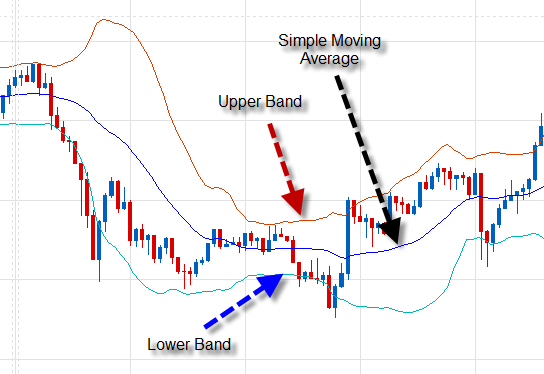Bollinger Bands Explained
Post on: 25 Июль, 2015 No Comment

How To Profit Using Bollinger Bands: A Widely Misused Technical Indicator
Comments ( )
By Ian Cooper
Tuesday, May 5th, 2009
The success of our options trading portfolio has my team’s email inboxes flooded with reader questions every day. I want to share as many of them as I can with you. so today let’s take a look at one from Michael R:
Ian, I’ve never made so much money than I have with you guys. With other services I’m trading, they also use Bollinger Bands, but I don’t understand them. Can you help?
Let me clear things up a bit.
Bollinger Bands are a popular technical indicator for traders to determine overbought and oversold conditions. In a range-bound market, for example, it works even better as prices travel between two rubber bands, or like balls bouncing off the walls of a racquetball game.
But using the Bollinger Band as a sole buy/sell indicator isn’t very smart. It’s why we also use W%R (Williams percentage range) and candlestick signals to help call tops and bottoms. As John Bollinger says, Tags of the bands are just that tags, not signals. A tag of the upper Bollinger band is not in and of itself a sell signal. A tag of the lower Bollinger band is not in and of itself a buy signal.
And if you try to use Bollinger Bands by themselves, you can get stopped out or worse as prices walk the bands without direction. Again, it’s why we use W%R and candlesticks, too.
As we said in How to Trade Like a Hedge Fund: Secrets of an Options Trader:
With Bollinger Bands (plotted at standard deviation levels above and below moving averages), stock prices tend to stay within the upper and lower bands. So when the prices move above the upper Bollinger Band, are coupled with a bearish candlestick read (gravestone doji, for example), and an extreme overbought W%R read is present, we expect a reversal at the top.
Bollinger Bands allow users to compare volatility and relative price levels over a period of time. They consist of three bands:
A simple moving average (SMA) in the middle.
An upper band (SMA plus 2 standard deviations).
A lower band (SMA minus 2 standard deviations).
Standard deviation, a statistical term that provides a good indication of volatility, ensures the bands will react to price movements and reflect periods of high and low volatility. Sharp price increases (or decreases) will lead to a widening of the bands.
In late November 2006, shares of AIG were grossly overbought, for example. Technically, once we got word of an extremely overbought W%R read (as seen in mid-November), we knew AIG was overdue for a correction. Also, notice the underlying stock crossed above the upper Bollinger Band with a doji cross at the time, indicating a near-term reversal which we got.
Or for another example, every time Forest Laboratories (FRX) touched the upper Bollinger Band, it would sell off.
The Best Free Investment You’ll Ever Make
Stay on top of the hottest investment ideas before they hit Wall Street. Sign up for the Wealth Daily newsletter below. You’ll also get our free report, Gold & Silver Mining Stocks.
Enter your email:
Let’s make this a bit simpler:

- When we use the Bollinger Bands, the closer the market prices move to the upper Bollinger Band, the more the stock market is considered overbought.
- The closer the prices move to the lower Bollinger Band, the more the stock market is considered oversold.
We’re not going to get into the scientific structures and Bollinger band calculations with each trade. We’ll be here until New Year’s 2012 doing that.
Again, using Bollinger Bands by themselves just won’t cut it. But the bands have become crucial in technical markets. By using the bands’ functionality and examining them as rubber bands that, when pulled too tight, can snap back to the mean, traders can achieve unimaginable profits. just as we have in Options Trading Pit .
Here’s another question from Marty C. Ian, do you recommend using stop losses and trailing stop losses?
Yes. In Options Trading Pit. we like to use a mental stop loss rule of at least -35%. With trailing stop losses, we like to use at least -25% when we’re showing a nice gain.
For instance, if you bought your option at $20, you might want to plug in a stop-loss order to sell if the price drops by 35% ($13).
On the other hand, if your option rises, you could set a trailing-stop. This is the opposite of a stop loss and locks in gains for you at a set level. For example, if you buy an option for $20 and it rises to $40, you could set a trailing stop at $30 to lock in a 50% gain.
Note: Make sure your broker understands that you want a stop-loss order and not a sell order otherwise he might execute the order immediately, and you could end up reselling an option worth $10 for $7.50. Simple mistakes like this illustrate why it is essential to find a broker you trust. or learn to trade for yourself.
Bottom line, give your broker instructions about your options. Don’t get left holding a worthless contract or shares you never intended to purchase.
That’s all for this week. Stay tuned for more shortly. And as always, if you have a question, feel free to e-mail it to us I may feature it in this daily e-letter.
For more on options trading, we direct your attention to the following:














